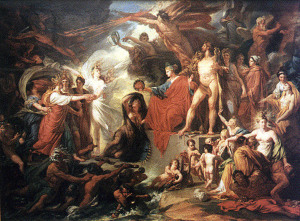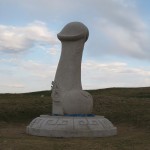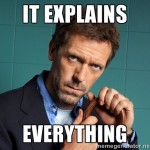The God of the Old Testament
The LORD said, “Go out and stand on the mountain in the presence of the LORD, for the LORD is about to pass by.” Then a great and powerful wind tore the mountains apart and shattered the rocks before the LORD, but the LORD was […] in the wind.
— 1 Kings 19:11 (NIV)
I once met the God of the Old Testament on a mountain. I was Mormon at the time and very much caught up in a perpetual and despairing cycle of “sin” (by which I mean fooling around with my girlfriend) and half-hearted repentance. One evening, a combination of sexual frustration and self-loathing sent me literally running up into the mountains that Brigham Young University is nestled up against. I was going to find God. I climbed the path up “Y” mountain — so called because of the giant letter “Y” painted on the side of the mountain. I don’t know how far up I got, because it was dark. It was cool outside, so it was probably late fall.
I remember leaving the path and climbing over some rocks. As reached the summit of the little pile I was climbing on, I looked over the edge and saw down into the valley between “Y” mountain and its neighbor to the south. Moonlight illuminated the valley. I was struck in the face by a freezing cold gust of air. It was beautiful and terrible I stood there for a moment, clinging to the rocks while being buffeted by the icy air. I would swear to you, the God of the Old Testament, Yahweh, was in that valley and in that wind: cold, hard, implacable … unforgiving. I climbed down in defeat and returned home.
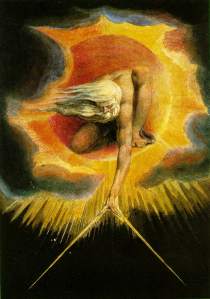
It was not until many years later that I realized that the God I met on the mountain, in fact the God that I knew as the Christian God, was part of me. The cold, hard, unforgiving God was the cold, hard, unforgiving part of myself.
Jung wrote that “only an unparalleled impoverishment of symbolism could enable us to rediscover the gods as psychic factors, which is to say, as archetypes of the unconscious.” The loss of my faith in Christianity was, for me, an “unparalleled impoverishment of symbolism”, but it enabled me to rediscover my gods. Yahweh was reborn as the Gnostic Demiurge, a tyrannical being that believes he is the Supreme God, because he has forgotten his real origin in his mother Sophia; he is patriarchy incarnate. I imagine him as Blake’s Urizen (above). Jesus was reborn as an image of Frazer’s dying and reviving pagan god. And the Holy Spirit was reborn as the Holy Body. Since then, I have not so much lost these old, as gained others. The God I know as Yahweh or Urizen is still part of me. But I have discovered others as well.
The Storm King
I conjure you […]
Though you untie the winds and let them fight
Against the churches, though the yeasty waves
Confound and swallow navigation up,
Though bladed corn be lodged and trees blown down,
Though castles topple on their warders’ heads,
Though palaces and pyramids do slope
Their heads to their foundations, though the treasure
Of nature’s germens tumble all together,
Even till destruction sicken …
— Shakespeare, Macbeth
The next god I met was a storm god. He was in the raging summer storm and in my own raging heart. I’ve written about him before here. I personified this feeling of rage and called him the “Storm King”. In some ways he was similar to Yahweh, in that both are angry storm gods. I suppose that makes sense, because I was transitioning away from Christianity. But I identified the Storm King with the warm summer storms, whereas I had met Yahweh/Urizen in the cold mountain winds.
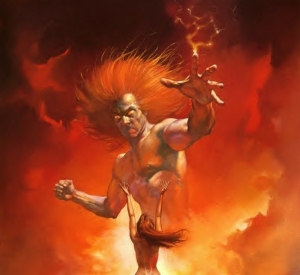
At the time, I had just left the LDS Church and I was raging against the perceived injustice of my situation. So it makes sense that I would discover this god next.
The Good Mother
“The mistake began when God was created in a male image. Of course, women would see Him that way, but men should have been gentlemen enough, remembering their mothers, to make God a woman! But the God of Gods–the Boss–has always been a man. That makes life so perverted, and death so unnatural. We should have imagined life as created in the birth-pain of God the Mother. Then we would understand why we, Her children, have inherited pain, for we would know that our life’s rhythm beats from Her great heart, torn with the agony of love and birth. And we would feel that death meant reunion with Her, a passing back into Her substance, blood of Her blood again, peace of Her peace! Now wouldn’t that be more logical and satisfying than having God a male whose chest thunders with egotism and is too hard for tired heads and thoroughly comfortless?”
— Eugene O’Neill, Strange Interlude
The next god I met was a goddess. After leaving the religion of my birth, I began an intense searching for myths and imagery to fill the void left by my the religion I had abandoned. I was not even entirely conscious of what doing at the time. As part of this search, I began collecting reproductions of paintings by the French Neo-Classical/Romantic painter William Bouguereau. I was especially drawn to a series of paintings of the Madonna and the Christ Child.
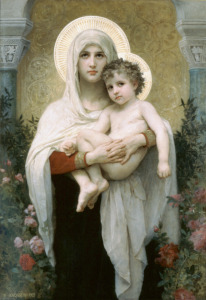
I still had not discovered Jung at this time. But later I realized that I was searching for imagery of the divine feminine to fill the gap which was created by the Mormon concept of a “Heavenly Mother”. That gap created, but remained unfilled even while I was in the Mormon Church, because Mormons are forbidden from speaking publicly about Her.
Later, upon reading Jung and Erich Neumann, I recognized this goddess as Bona Mater, the Good Mother. I suppose it is only natural that I would seek out a comforting maternal figure when retreating from an oppressive patriarchal deity. I also realized that she, like all of the gods, has a dark opposite: the Bad Mother, the Sow Who Devours Her Own Farrow. I recognized her in my own mother, just as I recognized Urizen in my father.
The Psychopomp
Atibon-Legba, remove the barrier for me, agoé!
Papa Legba remove the barrier
So I may pass through.
When I come back I will salute the loa.
— ritual song of greeting quoted in Metraux’s Voodoo in Haiti
The next god that I met was a psychopomp (soul-guide) I identified with the Norse god Odin and the Voudun loa called “Papa Legba”, the guardian of the spiritual crossroads. These are both gods that Jacob Rabinowitz correlates with the goddess Hecate in his book, The Rotting Goddess, because of their association with liminality.
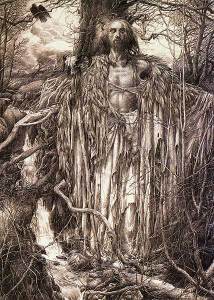
Odin was the first god I invoked in my own private Pagan ritual — my initiation into Pagan practice, a ritual that extended over nine nights and concluded with a portentous dream (more on that in a future post). It’s interesting how each of the gods I met corresponded with a stage in my spiritual development. Jung would say that the archetypes presented themselves when they were needed.
A pantheon of archetypes
Over the years, I came to discover other gods. Many of these gods were ones that I identified with (usually the male gods), while others I experienced as “other” (usually the female goddesses) — although according to Jung these are part of my Self as well.
With the guidance of writings by Jung, Joseph Campbell, and Robert Graves, I organized these into a pantheon. They included:
Animus Archetypes
(1a) the Sun Child, the son of the Good Mother and the Phallic Lord, representing innocence and possibility
(1b) the Dark Child, son of the Devouring Mother and the Thief of Sovereignty, representing the seed of destruction at the heart of every system
(2a) the Bright Youth, son of the Good Mother, the hero, representing consciousness striving toward individuation
(2b) the Red Dragon (a reference to William Blake’s art, as well as Robert Graves’ “Star-son and Serpent”), the Tanist, the Provoker of Strife (Caitlin Matthews’ term), son of the Devouring Mother, representing everything that impedes the Bright Youth in his quest for individuation
(3a) the Phallic Lord/Green Man, lover of the Lady of Beasts, related to the Stag God/Horned God of contemporary Neopaganism, representing un-repressed Eros and the flowering of desire
(3b) the Thief of Sovereignty (Caitlin Matthews’ term), ravisher of the Dark Maiden, leader of Wild Hunt at Samhain, representing the darker sexual desires, Eros merged with Thanatos
(4a) the Oak King/Harvest Lord/Dying God, consort to the Goddess of Sovereignty and victim of the Manslayer, representing the self-sacrifice of ego to the cycle of death and rebirth
(4b) the Holly King, the god who does not die, who refuses to sacrifice himself, representing the ego’s resistance to surrender. [This is the god who, according to Jane Harrison, chooses a form of immortality (athanasia), which is really a denial of life, in contrast of the ceaseless movement and rhythm of palingesesia of the Dying God.]
Anima Archetypes
(1aa) the Good Mother, Earth Mother, dea nutrix, mother of the Sun Child, representing the abundant and nurturing qualities of the material world
(1bb) the Devouring Mother, mother of the Dark Child, representing the destroying and consuming power of the material world
(2aa) the Maiden/Muse, the initiatrix who calls the Bright Youth to adventure, representing the inspiration which moves to action
(2bb) the Dark Maiden, the initiated, who is ravished by the Thief of Sovereignty, representing victimhood
(3aa) the Lady of the Beasts/Sovereignty, hetaira/heirodule, the Queen consort of the Oak King, representing the sex and sexual desire as holy
(3bb) the Dark Seductress, the Manslayer, slayer of the Harvest Lord, succubus/siren, she who devours her lover, the vagina dentata incarnate, symbolizing the loss of self that men fear about sex
(4aa/bb) Mother Night, the fertile darkness, the Abyss, representing the Unconscious and death, the womb and the tomb
There could be many other gods who would fit in this system, but these are the ones I have met. You will notice that each aspect has both light and dark and male and female aspects. The categories of the gods above correspond roughly to the stages in the life cycle of the Goddess and her consort, as described by Robert Graves in The White Goddess: (1) Birth, (2) Initiation, (3) Consummation, (4) Death/Repose; and also to the four seasons.
The gods without faces
Nature has become a company of spirits; every cave and fountain is haunted by a nymph; in the ocean dwell the Nereids, in the mountain the Oread, the Dryad in the wood; and everywhere, in groves and marshes, on the pastures or the rocky heights, floating in the current of the streams or traversing untrodden snows.
— G. Lowes Dickinson, The Greek View of Life
Eventually, I realized that my Paganism was too Self-centered and a I needed include the natural world in my practice more. In this way I met other gods. These were gods more like the Shinto kami or nature spirits than the Jungian archetypes above. Motoori Norinaga, an eighteenth-century interpreter of Shinto, wrote:
“it may be said that kami signifies, in the first place, the deities of heaven and earth that appear in the ancient records and also the spirits of the shrines where they are worshipped. It is hardly necessary to say that it includes human beings. It also includes such objects as birds, beasts, trees, plants, seas, mountains, and so forth. In ancient usage, anything whatsoever which was outside the ordinary, which possessed superior power, or which was awe-inspiring was called kami. Eminence here does not refer merely to the superiority of nobility, goodness, or meritorious deeds. Evil and mysterious things, if they are extraordinary and dreadful, are called kami.”
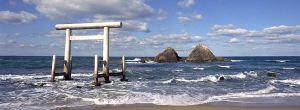
Recently I’ve been reading George Martin’s series, A Song of Ice and Fire, of which Game of Thrones is the first volume. In Martin’s fantasy world, there are three main religions and three pantheons, which correspond roughly to the gods I have been describing here. There is the faith of the “Lord of Light” and the evil “Great Other”, which resembles Manichaeism and some forms of Christianity. There is the faith of the Seven: Father, Mother, Warrior, Maiden, Smith, Crone, and the Stranger (Death) — who are all aspects of one God. This resembles the Jungian Neo paganismI have been describing above.
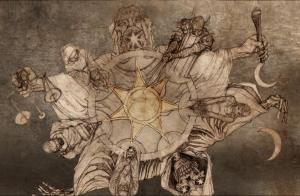
Finally, there is the faith of the Old Gods of the Forest, who are kind of animistic spirits who are worshiped in “godswoods”, each of which centered around a tree with a face carved in it. The gods I met in nature resembled Martin’s Old Gods.
I did not personify these gods. They are Sun, Water, Wind, Dirt, Blueness (Sky, Expanse), Storm, Greenness (Viriditas). They resemble Steven Posch’s “Oldest Tribe”. (More on the Old Gods here and here.)
Conclusion
These are my gods: gods of psyche and nature, gods with faces and gods without faces, the “hidden forces and blind necessities” of my life, the numinous immensities of my experience.

